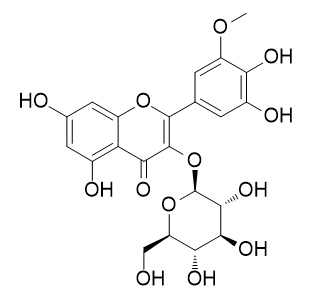Laricitrin 3-O-glucoside
Laricitrin 3-O-glucoside has antioxidant property.
Inquire / Order:
manager@chemfaces.com
Technical Inquiries:
service@chemfaces.com
Tel:
+86-27-84237783
Fax:
+86-27-84254680
Address:
1 Building, No. 83, CheCheng Rd., Wuhan Economic and Technological Development Zone, Wuhan, Hubei 430056, PRC
Providing storage is as stated on the product vial and the vial is kept tightly sealed, the product can be stored for up to
24 months(2-8C).
Wherever possible, you should prepare and use solutions on the same day. However, if you need to make up stock solutions in advance, we recommend that you store the solution as aliquots in tightly sealed vials at -20C. Generally, these will be useable for up to two weeks. Before use, and prior to opening the vial we recommend that you allow your product to equilibrate to room temperature for at least 1 hour.
Need more advice on solubility, usage and handling? Please email to: service@chemfaces.com
The packaging of the product may have turned upside down during transportation, resulting in the natural compounds adhering to the neck or cap of the vial. take the vial out of its packaging and gently shake to let the compounds fall to the bottom of the vial. for liquid products, centrifuge at 200-500 RPM to gather the liquid at the bottom of the vial. try to avoid loss or contamination during handling.
Braz J Med Biol Res. 2016, 49(7)
Nutrients.2021, 13(10):3414.
Adv. Anim. Vet. Sci.2024, 12(4):732-741
Molecular Simulation2023, 49(8):799-815.
Environ Toxicol.2022, 37(3):514-526.
J Sep Sci.2020, 201901140
Sci Rep.2019, 9(1):6429
Molecules.2019, 24(11):E2044
Molecules. 2013, 18(11):14105-21
Toxicol Res.2019, 35(4):371-387
Related and Featured Products
J Agric Food Chem. 2009 Jan 14;57(1):209-19.
Flavonol 3-O-glycosides series of Vitis vinifera Cv. Petit Verdot red wine grapes.[Pubmed:
19061313 ]
Petit Verdot grape skins by solid-phase extraction using a combination of reverse-phase and ion-exchanging materials. This procedure allowed us to separate a fraction of anthocyanin-free flavonol 3-O-glycosides that was further split into neutral and acidic subfractions, thus facilitating flavonol identification.
METHODS AND RESULTS:
By means of semipreparative reverse-phase high-performance liquid chromatography, we isolated several of these flavonol 3-O-glycosides for structural elucidation. The identification of different flavonol 3-O-glycosides was based on liquid chromatography-diode array detection-electrospray ionization-tandem mass spectrometry and NMR data when available.
CONCLUSIONS:
The results suggest that red grape flavonol 3-O-glycosides comprise three different complete series, according to the nature of the sugar moiety linked to the C-3 position. The 3-O-glucosides were the main derivative of the six possible flavonol aglycones (kaempferol, quercetin, isorhamnetin, myricetin, laricitrin, and syringetin), whereas the 3-O-galactoside derivatives were found as minor compounds for all of the flavonol aglycones. The 3-O-glucuronides are the third kind of red grape flavonol derivatives and normally account as minor compounds for all of the flavonol aglycones, with the exception of quercetin 3-O-glucuronide, which was as abundant as quercetin 3-O-glucoside. In addition, the presence of quercetin 3-O-(6"-rhamnosyl)-glucoside (rutin) was also detected as a trace compound in the skins of Petit Verdot grapes.
Molecules. 2012 Jul 25;17(8):8804-21.
Comparison on phenolic compounds and antioxidant properties of cabernet sauvignon and merlot wines from four wine grape-growing regions in China.[Pubmed:
22832882 ]
METHODS AND RESULTS:
The antioxidant activities in the Cabernet Sauvignon and Merlot wines from four wine grape-growing regions in China were measured by different analytical assays: 2,2-diphenyl-1-picrylhydrazyl (DPPH·), cupric reducing antioxidant capacity (CUPRAC), superoxide radical-scavenging activity (SRSA) and the contents of total phenols, total flavonoids, total flavanols and total anthocyanins were determined. The results showed that the contents of phenolic compounds and the levels of antioxidant activity in the wine samples greatly varied with cultivar and environmental factors of vine growth. The contents of phenolic compounds and antioxidant activities in Cabernet Sauvignon and Merlot wines from the Yuquanying region of Ningxia were significantly higher than other three regions, followed by the wines from Shacheng region of Hebei, and these parameters were the lowest in Cabernet Sauvignon and Merlot wines from the Changli regions of Hebei and Xiangning region of Shanxi.
CONCLUSIONS:
Taken together, a close relationship between phenolic subclasses and antioxidant activity was observed for the wine samples. Moreover, there were significant discrepancies in the individual phenolic composition and content of four regional Cabernet Sauvignon and Merlot wines, among which the individual phenolic compounds (catechin, epicatechin, cinnamic acid, quercetin-3-O-glucuronide, quercetin-3-O-glucoside, Laricitrin 3-O-glucoside and isorhamnetin-3-O-glucoside) revealed a significant correlation (p < 0.05) with the antioxidant capacity in present study, especially for catechin and epicatechin.



